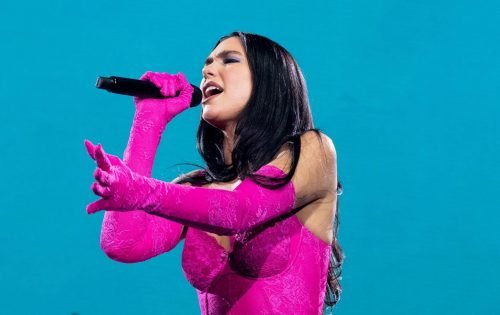Dua Lipa has rapidly ascended to global stardom, establishing herself as one of the most influential pop artists of the 21st century. Born in London to Albanian parents, Dua’s journey began with humble roots, uploading covers to YouTube before signing with Warner Bros. Records in 2014. Her self-titled debut album, released in 2017, catapulted her into the spotlight with hits like “New Rules” and “IDGAF,” earning her multiple awards and a dedicated fanbase.
In 2020, Dua Lipa released her sophomore album, Future Nostalgia, a bold and innovative project that cemented her status as a pop powerhouse. The album, heavily inspired by the disco and dance-pop sounds of the 70s and 80s, was a refreshing departure from contemporary trends, blending nostalgic elements with modern production. Tracks like “Don’t Start Now,” “Physical,” and “Levitating” showcased Dua’s versatility and knack for crafting infectious pop anthems.
Future Nostalgia made a profound impact on the music industry, revitalizing the disco genre and influencing a wave of artists to embrace retro sounds. The album received critical acclaim for its cohesive production, lyrical maturity, and Dua’s confident vocal performance. It dominated charts worldwide, secured numerous awards, including the Grammy for Best Pop Vocal Album, and solidified Dua Lipa’s position as a defining voice in modern pop music.
Concept and Inspiration
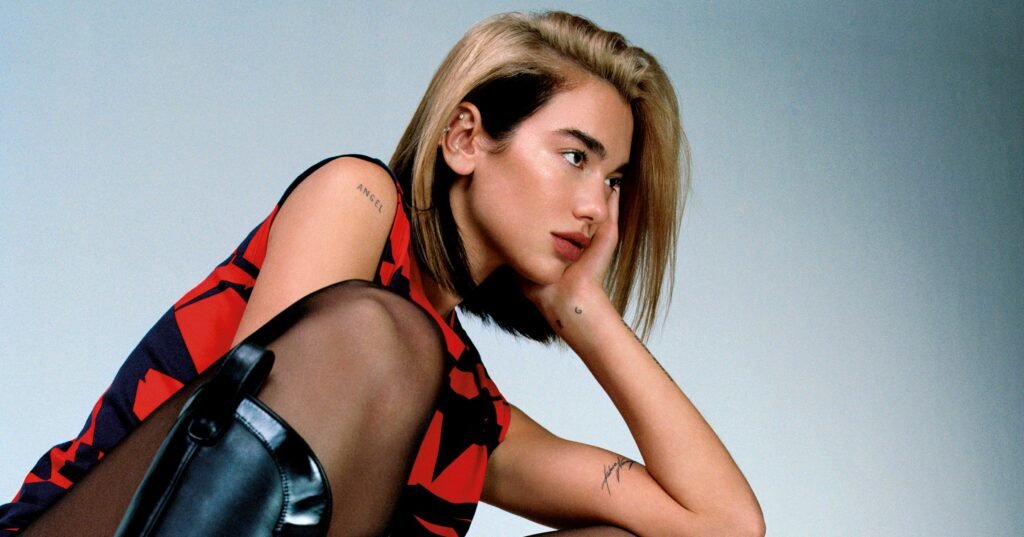
Dua Lipa’s Future Nostalgia is a vibrant homage to the disco era, blending the exuberance of the past with the sophistication of contemporary pop. The concept for the album emerged from Dua’s desire to create music that was both nostalgic and forward-thinking, offering listeners an escape and a sense of euphoria. In interviews, she expressed her intention to make a record that would make people dance and feel joyful, drawing inspiration from the music she grew up listening to with her parents.
The disco influences on Future Nostalgia are unmistakable, characterized by pulsating basslines, shimmering synths, and infectious rhythms. Dua Lipa’s choice to delve into this genre was a deliberate move to differentiate herself from the mainstream pop landscape, which was heavily dominated by trap and hip-hop sounds. She aimed to bring a sense of fun and glamour back to the dance floor, echoing the hedonistic spirit of the late 70s and early 80s.
Key Inspirations
Key inspirations for the album include iconic artists and genres that shaped the disco era. Dua has cited Madonna, Kylie Minogue, and OutKast as significant influences, blending their innovative styles with her own unique vision. Madonna’s fearless reinvention and boundary-pushing approach resonated deeply with Dua, inspiring her to take creative risks. Kylie Minogue’s ability to merge pop with dance music provided a blueprint for crafting catchy, danceable tracks. Additionally, the eclectic soundscapes of OutKast introduced an element of genre-blending that allowed Dua to experiment with different musical textures.
Furthermore, Dua’s immersion in the works of legends like Prince, Nile Rodgers, and Daft Punk contributed to the album’s sonic palette. Prince’s funk-driven grooves, Nile Rodgers’ signature guitar riffs, and Daft Punk’s electronic disco revivalism all left their mark on Future Nostalgia. The album’s title track, “Future Nostalgia,” encapsulates this fusion of past and future, setting the tone for a collection of songs that celebrate the timeless allure of disco while pushing the boundaries of modern pop music.
Songwriting and Production

The songwriting process for Future Nostalgia was a collaborative effort marked by experimentation and a clear vision of blending the past with the present. Dua Lipa co-wrote every track on the album, ensuring that her personal experiences and artistic vision were woven into the fabric of the music. The writing sessions were characterized by a sense of freedom and creativity, with Dua and her team drawing inspiration from various eras and genres to craft a sound that was both nostalgic and innovative.
Central to the creation of Future Nostalgia were several key producers and collaborators who helped shape the album’s distinctive sound. Among the most notable were Jeff Bhasker, Ian Kirkpatrick, Stuart Price, and The Monsters & Strangerz. Each brought their unique expertise and style to the project, contributing to the album’s rich and diverse sonic landscape.
Jeff Bhasker, known for his work with artists like Kanye West and Bruno Mars, brought a polished, modern touch to the production, blending electronic elements with live instrumentation. Ian Kirkpatrick, who previously worked with Dua on her hit single “New Rules,” was instrumental in creating the album’s infectious pop hooks and dynamic arrangements. Stuart Price, a veteran producer famous for his work with Madonna and The Killers, infused the tracks with a disco essence, utilizing his deep understanding of the genre to create authentic, danceable grooves. The Monsters & Strangerz, a production duo with a knack for crafting hit records, added their signature style, blending catchy melodies with sleek, contemporary production techniques.
The Recording Sessions
The recording sessions for Future Nostalgia were characterized by a spirit of exploration and a commitment to authenticity. Dua Lipa and her collaborators spent countless hours in the studio, experimenting with different sounds, arrangements, and lyrical ideas. The process often involved blending analog and digital recording techniques to achieve a timeless yet modern feel. Vintage synthesizers, live drums, and guitar riffs were seamlessly integrated with contemporary production tools, creating a sound that honored the past while looking to the future.
One of the key creative decisions was the use of live instrumentation to capture the energy and spontaneity of classic disco records. Tracks like “Levitating” and “Physical” feature live basslines and guitar riffs that add a sense of warmth and immediacy to the music. Additionally, the use of layered vocal harmonies and intricate backing vocals helped to create a lush, full-bodied sound that is both retro and modern.
Dua Lipa’s hands-on approach extended beyond songwriting and into the production process, where she worked closely with her collaborators to ensure that every element of the album aligned with her artistic vision. This included experimenting with different vocal techniques and delivery styles to match the mood and energy of each track. The result is an album that feels cohesive and meticulously crafted, with each song contributing to the overarching theme of Future Nostalgia.
Key Tracks Analysis
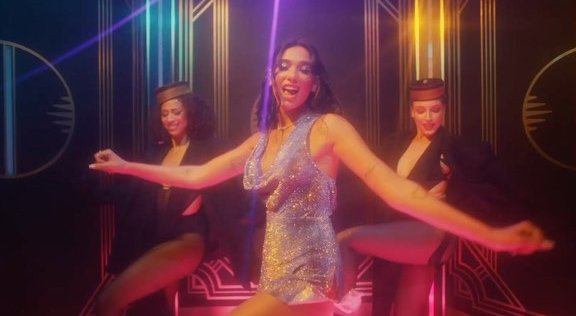
Future Nostalgia is packed with standout tracks that have become modern pop anthems, each contributing to the album’s overall success and distinct sound. Here’s a closer look at three of the most iconic tracks: “Don’t Start Now,” “Physical,” and “Levitating.”
“Don’t Start Now”
“Don’t Start Now” was the lead single from Future Nostalgia, setting the tone for the entire album. The song’s production, led by Ian Kirkpatrick, features a tight, funky bassline, shimmering synths, and a pulsating beat that echoes the best of disco’s golden era. Lyrically, the song is a powerful declaration of independence and self-assurance, with Dua singing about moving on from a past relationship. The infectious chorus, “Don’t show up, don’t come out, don’t start caring about me now,” became an empowering anthem for many listeners.
The reception of “Don’t Start Now” was overwhelmingly positive. Critics praised its catchy hooks and danceable rhythm, while fans embraced it as a dance floor staple. The song’s success was reflected in its chart performance, peaking at number two on the Billboard Hot 100 and earning multiple platinum certifications worldwide. Its accompanying music video, with its vibrant, retro aesthetic, further solidified the song’s impact.
“Physical”
“Physical” is a high-energy track that pays direct homage to the aerobics craze of the 1980s, drawing inspiration from Olivia Newton-John’s classic hit of the same name. Produced by Jason Evigan and Koz, the song features a driving beat, explosive synths, and an urgent tempo that compels listeners to move. The commanding chorus, “Come on, let’s get physical,” is a call to action that captures the song’s kinetic energy.
Thematically, “Physical” is about the intense and exhilarating experience of falling in love. Its lyrics convey a sense of urgency and passion, perfectly matched by the song’s relentless pace. The track was a commercial success, charting in multiple countries and receiving critical acclaim for its bold production and nostalgic flair. The music video, with its vibrant, neon-colored visuals and high-energy choreography, perfectly complements the song’s retro-futuristic vibe.
“Levitating”
“Levitating” is arguably one of the most beloved tracks on Future Nostalgia, featuring an irresistible blend of funk, pop, and disco elements. Produced by Koz and Stuart Price, the song is built around a bouncy bassline, sparkling synths, and a catchy, rhythmic chorus. The track showcases Dua Lipa’s vocal versatility, as she effortlessly navigates between smooth verses and an anthemic chorus.
Lyrically, “Levitating” is a celebration of love and the feeling of being uplifted by a romantic connection. The lyrics, “You want me, I want you, baby,” capture the playful and joyous essence of the song. The track’s infectious energy made it a favorite among fans and a staple in Dua Lipa’s live performances. The song’s popularity was further boosted by a remix featuring DaBaby, which helped it reach new audiences and climb the charts, eventually peaking within the top ten in multiple countries.
The reception of “Levitating” was enthusiastic, with critics highlighting its catchy melody and feel-good vibe. The song’s success on streaming platforms and radio airplay underscored its wide appeal, making it one of the defining tracks of Future Nostalgia.
Visual and Aesthetic Choices
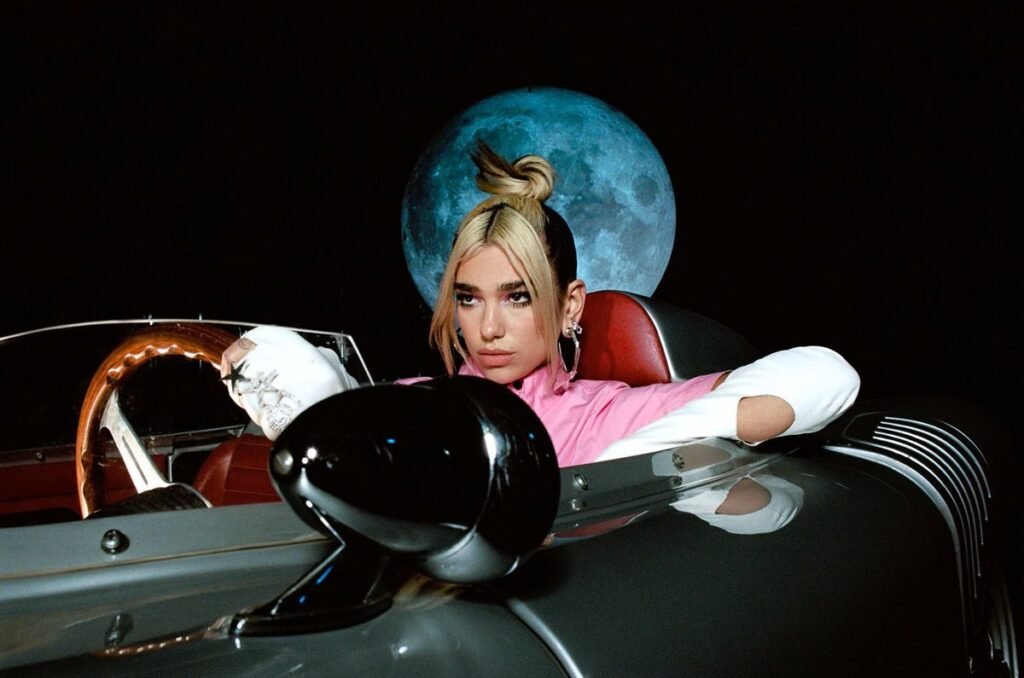
The visual branding of Future Nostalgia is a masterclass in retro-futuristic aesthetics, capturing the vibrant spirit of the 80s while projecting a sleek, modern edge. Dua Lipa and her creative team meticulously crafted the album’s visuals to complement its musical themes, resulting in a cohesive and striking artistic vision that enhances the listener’s experience.
Album Art
The album cover for Future Nostalgia immediately sets the tone with its bold, eye-catching design. Shot by renowned photographer Hugo Comte, the cover features Dua Lipa in a dynamic pose against a night sky backdrop, exuding confidence and glamour. She wears a pink, high-collared blouse, white gloves, and large hoop earrings—an ensemble that nods to 80s fashion. The vintage car in the foreground and the futuristic typography further blend past and present, perfectly encapsulating the album’s title and thematic essence.
Music Videos
The music videos for Future Nostalgia are visual feasts that extend the album’s retro-futuristic aesthetic. Each video is meticulously designed to evoke the 80s while incorporating modern elements, creating a unique and immersive visual experience.
“Don’t Start Now”: The video for “Don’t Start Now,” directed by Nabil Elderkin, features vibrant, neon-lit scenes reminiscent of 80s nightclubs. Dua Lipa’s choreography and fashion—sparkly outfits and bold makeup—enhance the disco vibe. The video’s dynamic cuts and energetic dance sequences mirror the song’s infectious rhythm and empowering message.
“Physical”: Directed by CANADA, the “Physical” video is a high-energy, technicolor extravaganza. It draws heavy inspiration from 80s aerobics and action films, featuring Dua Lipa in a series of vividly colored, athletic outfits. The video is set in a surreal, kaleidoscopic world filled with geometric shapes and neon lights, perfectly matching the song’s pulsating beat and high-octane energy.
“Levitating”: The video for “Levitating,” directed by Warren Fu, is a playful blend of retro and space-age themes. It features Dua Lipa in a disco-inspired outfit, complete with glitter and platform shoes, aboard a futuristic elevator that travels through a dazzling, starry universe. The video’s whimsical visuals and slick choreography highlight the song’s buoyant, celebratory mood.
Influence of 80s Aesthetics
The influence of 80s aesthetics on Future Nostalgia‘s visual presentation is pervasive and intentional. This era, known for its bold colors, geometric patterns, and glamorous fashion, serves as a rich source of inspiration. The album’s visual style is characterized by several key elements drawn from the 80s:
Fashion: The fashion choices throughout Future Nostalgia are a clear homage to 80s trends. Dua Lipa frequently dons high-waisted pants, oversized blazers, and metallic fabrics, all staples of the decade’s fashion. Her bold makeup, featuring bright eyeshadows and glossy lips, further reinforces the retro vibe.
Color Palette: The use of neon and pastel colors is a defining feature of the album’s visuals. These vibrant hues are a hallmark of 80s design, adding to the nostalgic feel while maintaining a contemporary edge.
Graphic Design: The typography and graphic elements used in the album art and promotional materials are heavily influenced by 80s design principles. Bold, sans-serif fonts, geometric shapes, and grid patterns create a futuristic yet retro aesthetic that is visually captivating.
Cultural Impact
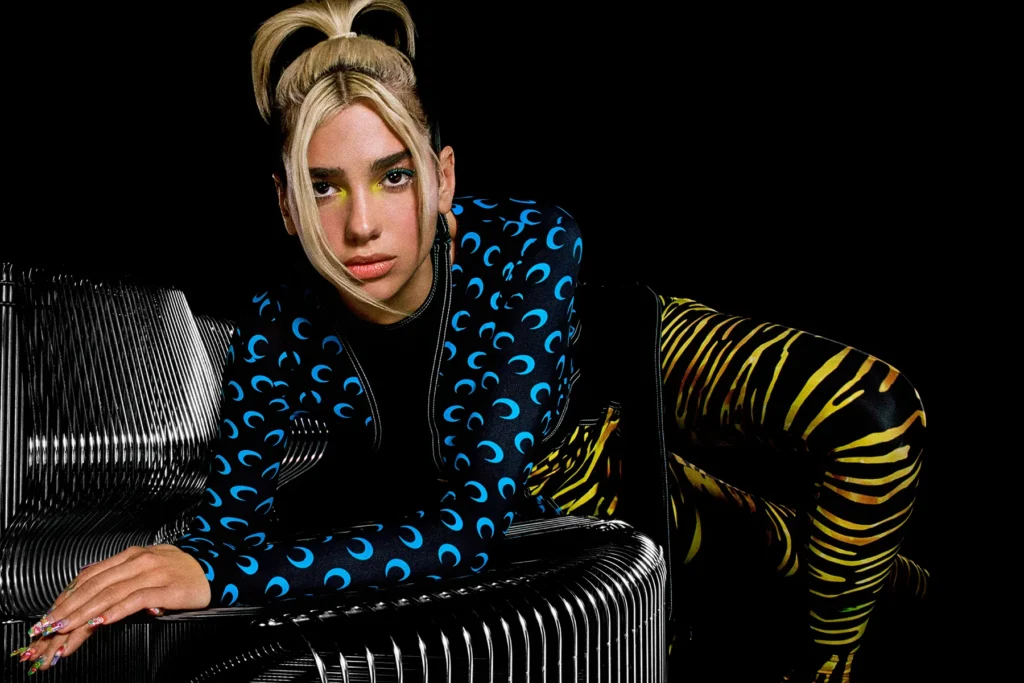
Future Nostalgia has had a profound influence on contemporary pop music, reinvigorating the genre with its vibrant blend of disco and modern pop elements. Released at a time when much of mainstream music was dominated by minimalist beats and trap influences, Dua Lipa’s bold choice to embrace a retro aesthetic stood out, creating a ripple effect throughout the industry.
Influence on Contemporary Pop Music
The success of Future Nostalgia has prompted a noticeable shift in the musical landscape. Other artists have increasingly adopted retro elements, incorporating disco-inspired beats, funky basslines, and lush synths into their own music. This trend is evident in the work of artists like The Weeknd, who embraced a synthwave sound on his album After Hours, and Miley Cyrus, whose album Plastic Hearts features a rock and disco fusion.
Dua Lipa’s seamless blending of past and present has set a new standard for pop production, encouraging artists to explore deeper, richer soundscapes and to draw inspiration from a variety of eras. The album’s polished, high-energy tracks have also raised the bar for what pop music can achieve in terms of both musicality and production quality.
Resurgence of Disco and Retro Styles
Future Nostalgia has played a pivotal role in the resurgence of disco and retro styles within popular culture. By successfully modernizing the sounds of the late 70s and early 80s, Dua Lipa has helped to reintroduce these genres to a new generation of listeners. This revival is not just limited to music but extends to fashion, film, and other areas of popular culture.
The album’s influence can be seen in the increased presence of disco-inspired fashion on runways and in streetwear, with designers embracing bold colors, metallic fabrics, and vintage silhouettes. Music videos and live performances have also begun to feature more elaborate choreography and vibrant visual aesthetics, drawing directly from the disco era’s emphasis on showmanship and spectacle.
Moreover, Future Nostalgia has brought a renewed appreciation for the artistry and craftsmanship of disco music. The genre, which once faced criticism and backlash, is now celebrated for its contributions to dance music and its role in shaping modern pop. This reevaluation has led to a broader acceptance and incorporation of disco elements in various musical genres, from electronic dance music to indie pop.
Impact on the Music Industry
The album’s commercial success and critical acclaim have reinforced the viability of taking creative risks in the music industry. Future Nostalgia has shown that there is a substantial audience for well-crafted, genre-blending music that respects its influences while pushing boundaries. This has encouraged labels and artists to invest in more diverse and innovative projects, fostering a more vibrant and varied musical landscape.
Dua Lipa’s strategic use of nostalgia, paired with her contemporary sensibilities, has also influenced marketing and promotional strategies within the industry. By creating a strong visual and thematic brand for the album, she has demonstrated the power of cohesive storytelling and branding in building a successful music campaign. This approach has been adopted by other artists looking to create immersive and engaging experiences for their audiences.
Closing Thoughts
Future Nostalgia has left an indelible mark on contemporary pop music, sparking a resurgence of disco and retro styles while encouraging artistic innovation and creativity. Dua Lipa’s masterful blend of past and present has not only revitalized the genre but also set a new standard for what pop music can be. The album’s cultural impact continues to resonate, influencing artists, fashion, and the music industry at large, proving that the magic of disco and the allure of nostalgia are timeless.
